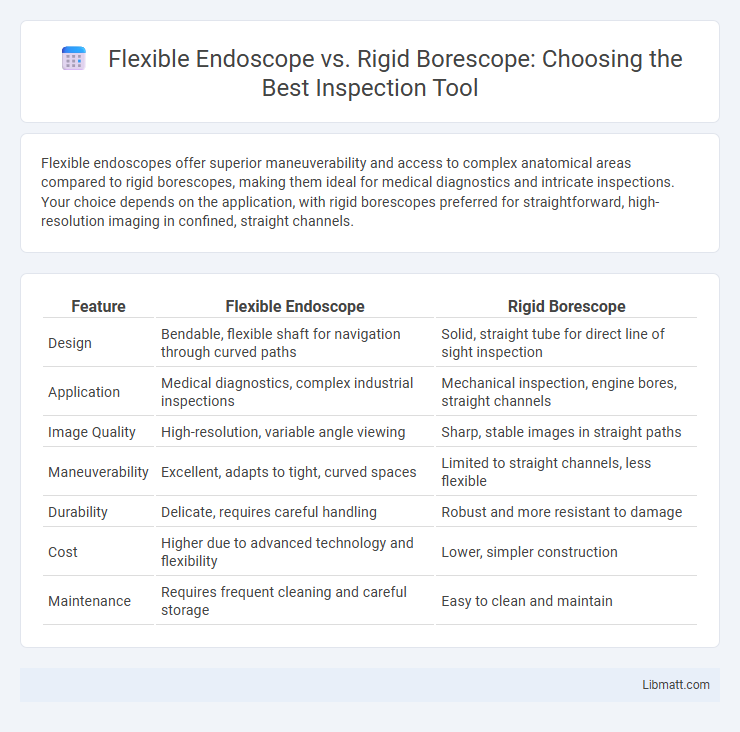Flexible endoscopes offer superior maneuverability and access to complex anatomical areas compared to rigid borescopes, making them ideal for medical diagnostics and intricate inspections. Your choice depends on the application, with rigid borescopes preferred for straightforward, high-resolution imaging in confined, straight channels.
Table of Comparison
| Feature | Flexible Endoscope | Rigid Borescope |
|---|---|---|
| Design | Bendable, flexible shaft for navigation through curved paths | Solid, straight tube for direct line of sight inspection |
| Application | Medical diagnostics, complex industrial inspections | Mechanical inspection, engine bores, straight channels |
| Image Quality | High-resolution, variable angle viewing | Sharp, stable images in straight paths |
| Maneuverability | Excellent, adapts to tight, curved spaces | Limited to straight channels, less flexible |
| Durability | Delicate, requires careful handling | Robust and more resistant to damage |
| Cost | Higher due to advanced technology and flexibility | Lower, simpler construction |
| Maintenance | Requires frequent cleaning and careful storage | Easy to clean and maintain |
Introduction to Flexible Endoscopes and Rigid Borescopes
Flexible endoscopes feature bendable insertion tubes that navigate complex internal pathways, ideal for medical and industrial inspections where maneuverability is crucial. Rigid borescopes consist of a straight, solid tube offering high image clarity and durability, commonly used in automotive and aerospace applications for direct-line viewing. Understanding the differences in flexibility and optical performance helps you select the right tool for precision inspection tasks in challenging environments.
Fundamental Differences Between Flexible Endoscope and Rigid Borescope
Flexible endoscopes offer maneuverability with a bendable insertion tube, allowing access to complex or curved anatomical or mechanical structures, while rigid borescopes have a straight, solid shaft providing high image quality and durability but limited flexibility. Flexible endoscopes typically use fiber optics or digital imaging to transmit visuals, enabling inspection in confined or tortuous spaces, whereas rigid borescopes utilize direct optical lenses for clear, high-resolution views in straight passages. Your choice depends on the inspection environment: flexible endoscopes suit intricate pathways, while rigid borescopes excel in stable, linear applications requiring precise imaging.
Design and Construction: Flexible vs. Rigid
Flexible endoscopes feature a versatile design with a bendable insertion tube composed of numerous articulated segments, allowing navigation through complex and curved pathways within the body. Rigid borescopes have a solid, straight tube constructed from durable materials like stainless steel, providing stable, high-resolution imaging for inspecting straight or less accessible areas. Your choice between flexible and rigid instruments depends on the specific inspection requirements and the complexity of the environment to be examined.
Image Quality Comparison
Flexible endoscopes offer superior maneuverability but typically provide lower image resolution compared to rigid borescopes, which deliver higher-definition visuals due to their stable, straight design and premium optics. Rigid borescopes incorporate advanced lenses and lighting systems, resulting in clearer, more detailed images ideal for precision inspection tasks. The trade-off between flexibility and image clarity is a crucial consideration when selecting between the two for medical or industrial applications.
Maneuverability and Access Capabilities
Flexible endoscopes offer superior maneuverability with their ability to bend and navigate through complex or curved anatomical pathways, making them ideal for inspecting confined or hard-to-reach areas such as the gastrointestinal tract or bronchial tubes. Rigid borescopes provide a straight, fixed view that limits access to only straightforward or linear pathways, but they deliver higher image stability and are often preferred for inspecting industrial equipment or fixed tunnels. The choice between flexible endoscopes and rigid borescopes depends on the required access capabilities and the complexity of the inspection environment.
Applications in Industrial and Medical Settings
Flexible endoscopes excel in medical settings by providing minimally invasive access to complex anatomical pathways for diagnostic and surgical procedures, particularly in gastroenterology and pulmonology. Rigid borescopes are preferred in industrial applications for inspecting machinery, engines, and turbines due to their durability and ability to deliver high-quality images of confined spaces with limited bending. Both tools are essential for non-destructive testing but differ significantly in flexibility, image clarity, and suitability for medical versus industrial environments.
Durability and Maintenance Considerations
Flexible endoscopes feature a delicate design with fiber optics and bending components, making their durability lower compared to rigid borescopes, which have a solid metal construction resistant to wear and tear. Maintenance for flexible endoscopes is more demanding, requiring careful cleaning and sterilization protocols to prevent damage and contamination, whereas rigid borescopes are easier to clean and maintain due to their simpler build. Your choice will depend on weighing the trade-offs between flexibility, durability, and the complexity of upkeep.
Cost Analysis and Budget Implications
Flexible endoscopes generally have higher upfront costs due to advanced technology and enhanced maneuverability features, but they offer greater diagnostic versatility, which can reduce long-term expenses in diverse clinical settings. Rigid borescopes are typically less expensive initially and require lower maintenance costs, making them suitable for budget-conscious facilities with limited procedural needs. Evaluating your specific diagnostic requirements and budget constraints is essential to determine the most cost-effective option for your medical practice or industrial inspection.
User Experience and Training Requirements
Flexible endoscopes offer enhanced maneuverability and real-time navigation, providing operators with greater ease in inspecting complex or curved anatomical structures, which often reduces the learning curve compared to rigid borescopes. Rigid borescopes require more specialized training due to their limited flexibility and need for precise alignment, making user proficiency critical for accurate inspections. Overall, flexible endoscopes improve user experience by enabling intuitive handling and quicker mastery, while rigid borescopes demand higher technical skill and practice for effective operation.
Choosing the Right Tool: Flexible Endoscope or Rigid Borescope?
Choosing the right tool depends on inspection requirements: flexible endoscopes offer superior maneuverability for complex or curved spaces, while rigid borescopes provide higher image clarity and durability for straight, easily accessible areas. Your decision should consider factors like workspace constraints, desired image resolution, and the level of flexibility needed to navigate tight or angled paths. Selecting the appropriate device ensures efficient, accurate diagnostics and minimizes equipment damage risks.
Flexible endoscope vs rigid borescope Infographic

 libmatt.com
libmatt.com